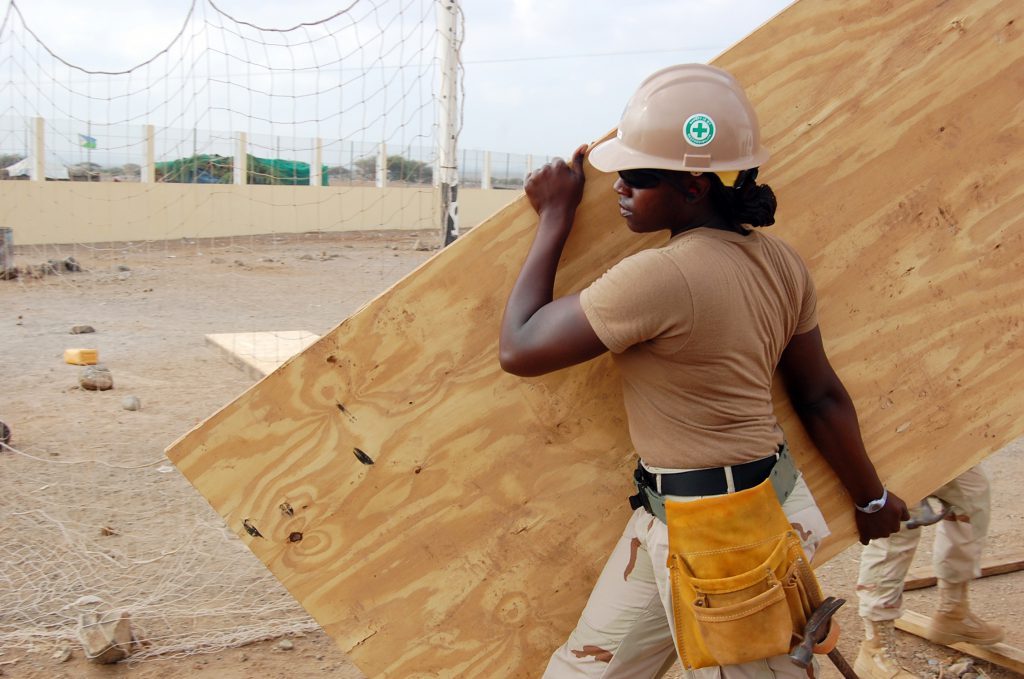
Pre-employment training, affordable childcare are key, National Skills Coalition says.
Tannasia, a newly single mother of four kids, was forced to uproot her family from their home in Texas to Biloxi, Mississippi after severe flooding hit the state.
And that’s when she found herself stuck. Tannasia needed a job, badly. But she couldn’t get a job because she couldn’t afford child care, and she couldn’t afford child care because she didn’t have a job.
But Tannasia caught a break. She came across a flier for the Moore Community House Women in Construction (WinC) program, an eight-week construction pre-apprenticeship program that prepares women for work in advanced manufacturing and construction. Not only does WinC help its participants move on to paid apprenticeship programs (and eventual jobs), it also provides child care assistance.
“This program saved my life, and my kids’ life,” Tannasia said. “I don’t know where we’d be without Women in Construction. I was stuck between a rock and a hard place, and it opened a door for me when I didn’t have any way out.”
There is a lot of talk these days about the need for more apprenticeship programs — and not just because of this whole situation.
Both the public and private sector are looking for ways to prepare America’s workers for the high-tech jobs of tomorrow, especially in advanced manufacturing. And while here at AAM we believe some of the talk about the “skills gap” has been a bit overstated, there’s no doubt that more must be done to better recruit and prepare people for middle-skill jobs that require education beyond high school (but not a four-year college degree).
The National Skills Coalition has a few ideas on how to do just that.
The organization is out with a new policy briefing that outlines ways to increase the number of apprentices and other forms of work-based learning. The United States “falls far behind competitor nations” in using such training for in-demand jobs, the coalition notes. The U.S. is even worse at recruiting women, parents, and underrepresented people for such programs.
One of the reasons is that these folks often need “pre-employment” training, like the program that Tannasia went through, to gain the skills they need to begin an apprenticeship program.
Often run by a community-based organization or a community or technical college, successful programs allow potential apprenticeships to gain occupational skills, usually over the course of eight to 12 weeks, along with hands-on worksite experience like working with tools, machinery and other project materials. In addition, these programs also help participants get into apprenticeship programs, along with financial and career planning, job search assistance, networking opportunities and more.
These programs work. One 2003 study “found that pre-apprenticeship training helped more than 5,000 women enter apprenticeship over the prior ten-year period,” the coalition reports.
But even if program participants make it to an apprenticeship program, many still hit a wall because they lack childcare.
“When parents are in the workforce, significant child care costs make entering unpaid training like pre-apprenticeship nearly impossible,” the coalition notes. “Child care expenses for families with young children average more than $700 a month nationally. For single-parent families, these costs account for more than a third of their monthly income.”
Access to affordable child care is simply a game-changer for many of these apprentices. One study found that when given a child care subsidy, the likelihood that a single mother participates in a job training program increases by 8 percentage points; in another survey, 48 percent of low-income participants in job training programs who received child care said they wouldn’t have been able to complete the program without it.
Just like Tannasia — and she's not alone. The WinC program began offering its participants and graduates child care in 2016 after receiving a series of grants. Since then, enrollment has nearly tripled, from about 60 women per year to 180 women per year.
Read the full briefing, which includes specific policy recommendations for Congress and state policymakers.
Editor's note: AAM President Scott Paul is the current board chair of the National Skills Coalition.
